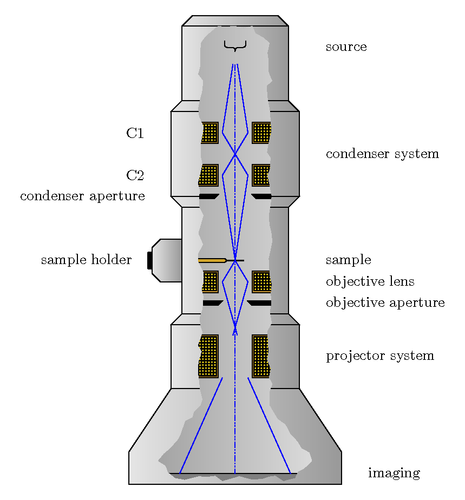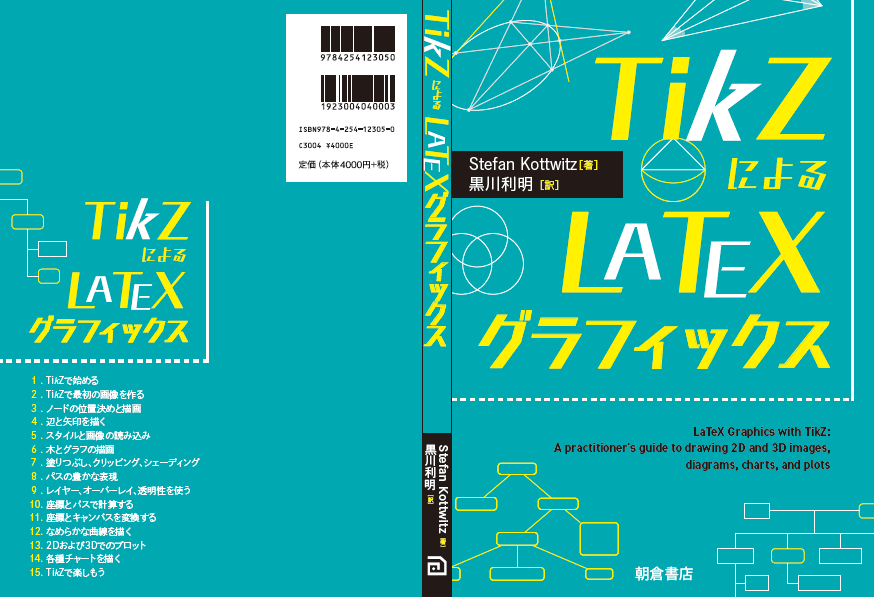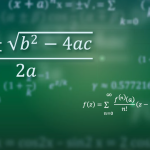The general Transmission Electron Microscope (TEM) system. At the top of the TEM is the source of the free electrons. Directly below the source is the condenser system. The condenser system focuses the electrons onto the sample. Below the sample is the objective lens and aperture which collect and convey the electrons to the projector system. The projector system (drawn here as a large lens) usually consists of 2-3 lenses and 1-3 apertures. The imaging surface shown here could be a phosphor screen or the entrance to a CCD camera imaging system.

Edit and compile if you like:
% Transmission Electron Microscope System
% Author: Eric Jensen
\documentclass[a4paper,10pt]{article}
\usepackage{tikz}
\usepackage[active,tightpage]{preview}
\PreviewEnvironment{tikzpicture}
\setlength{\PreviewBorder}{10pt}%
\usetikzlibrary{calc, decorations.pathmorphing, fadings, shadings}
\begin{document}
\begin{tikzpicture}
\draw[gray,fill=gray,path fading=south] (0,0) rectangle +(0.3,-0.3);% <- MAGIC
% (if this is not present none of the shadings work)
%top
\shade[left color=black!10!white,right color=black!40!white] (-1,0.75)
-- ++(2,0) -- ++(0.25,-0.25) -- ++(-2.5,0) -- cycle;
\draw (-1,0.75) -- ++(2,0) -- ++(0.25,-0.25) -- ++(-2.5,0) -- cycle;
%source
\shade[left color=black!10!white,right color=black!40!white] (1.25,0.5)
-- ++(0,-1.75) -- ++(-2.5,0) -- ++(0,1.75) -- cycle;
\draw (1.25,0.5) -- ++(0,-1.75) -- ++(-2.5,0) -- ++(0,1.75) -- cycle;
%top condenser system
\shade[left color=black!10!white,right color=black!40!white] (1.25,-1.25)
-- ++(0.25,-0.25) -- ++(-3,0) -- ++(0.25,0.25) -- cycle;
\draw (1.25,-1.25) -- ++(0.25,-0.25) -- ++(-3,0) -- ++(0.25,0.25) -- cycle;
%condenser system
\shade[left color=black!10!white,right color=black!40!white] (1.5,-1.5)
-- ++(0,-2) -- ++(-3,0) -- ++(0,2) -- cycle;
\draw (1.5,-1.5) -- ++(0,-2) -- ++(-3,0) -- ++(0,2) -- cycle;
%condenser bottom
\shade[left color=black!10!white,right color=black!40!white] (1.5,-3.5)
-- ++(-0.25,-0.25) -- ++(-2.5,0) -- ++(-0.25,0.25) -- cycle;
\draw (1.5,-3.5) -- ++(-0.25,-0.25) -- ++(-2.5,0) -- ++(-0.25,0.25) -- cycle;
%specimen and objective
\shade[left color=black!10!white,right color=black!40!white] (1.25,-3.75)
-- ++(0,-2.5) -- ++(-2.5,0) -- ++(0,2.5) -- cycle;
\draw (1.25,-3.75) -- ++(0,-2.5) -- ++(-2.5,0) -- ++(0,2.5) -- cycle;
%projector system top
\shade[left color=black!10!white,right color=black!40!white] (1.25,-6.25)
-- ++(0.25,-0.25) -- ++(-3,0) -- ++(0.25,0.25) -- cycle;
\draw (1.25,-6.25) -- ++(0.25,-0.25) -- ++(-3,0) -- ++(0.25,0.25) -- cycle;
%projector system
\shade[left color=black!10!white,right color=black!40!white] (1.5,-6.5)
-- ++(0,-1.5) -- ++(-3,0) -- ++(0,1.5) -- cycle;
\draw (1.5,-6.5) -- ++(0,-1.5) -- ++(-3,0) -- ++(0,1.5) -- cycle;
%image
\shade[left color=black!10!white,right color=black!40!white] (1.5,-8)
-- ++(1,-1.5) -- ++(0,-0.75) -- ++(-5,0) -- ++(0,0.75) -- ++(1,1.5) -- cycle;
\draw (1.5,-8) -- ++(1,-1.5) -- ++(0,-0.75) -- ++(-5,0) -- ++(0,0.75)
-- ++(1,1.5) -- cycle;
%sample entrance
\shade[left color=black!10!white,right color=black!40!white] (-1.25,-4.5)
-- ++(-0.5,0) -- ++(-0.2,-0.2) -- ++(0,-0.6) -- ++(0.2,-0.2)
-- ++(0.5,0) -- cycle;
\draw (-1.25,-4.5) -- ++(-0.5,0) -- ++(-0.2,-0.2) -- ++(0,-0.6)
-- ++(0.2,-0.2) -- ++(0.5,0) -- cycle;
%sample holder
\draw[fill=black] (-1.95,-4.8) -- ++(-0.08,0) -- ++(-0.02,-0.02)
-- ++(0,-0.36) -- ++(0.02,-0.02) -- ++(0.08,0) -- cycle;
%inside
\begin{scope}
\path[clip,decoration={random steps, segment length=6pt, amplitude=2pt},
decorate] (0,0.5) -- ++(0.4,0) -- ++(0.4,-0.4) -- ++(0,-8.5)
-- ++(1,-1.3) -- ++(-0.4,-0.4) -- ++(-2.8,0) -- ++(-0.4,0.4)
-- ++(1,1.3) -- ++(0,8.5) -- ++(0.4,0.4) -- cycle;
\shade[left color=black!40!white,right color=black!10!white] (-1,0.75)
-- ++(2,0) -- ++(0.25,-0.25) -- ++(0,-1.75) -- ++(0.25,-0.25) -- ++(0,-2)
-- ++(-0.25,-0.25) -- ++(0,-2.5) -- ++(0.25,-0.25) -- ++(0,-1.5)
-- ++(1,-1.5) -- ++(0,-0.75) -- ++(-5,0) -- ++(0,0.75) -- ++(1,1.5)
-- ++ (0,1.5) -- ++(0.25,0.25) -- ++(0,2.5) -- ++(-0.25,0.25) -- ++(0,2)
-- ++(0.25,0.25) -- ++(0,1.75) -- cycle;
%source
\draw (-0.25,0.15) -- ++(0,-0.05) .. controls +(0,-0.08) and +(-0.08,0)
.. ++(0.1,-0.1) -- ++(0.05,0) .. controls +(0.08,0) and +(0,0.08)
.. ++(0.1,-0.1) .. controls +(0,0.08) and +(-0.08,0) .. ++(0.1,0.1) --
++(0.05,0) .. controls +(0.08,0) and +(0,-0.08) .. ++(0.1,0.1) -- ++(0,0.05);
%C1
\draw[fill=brown!80!yellow] (-0.4,-1.75) -- ++(-0.5,0) -- ++(0,-0.5)
-- ++(0.5,0) -- cycle;
\draw (-0.4,-1.75) ++(-0.04,-0.04) -- ++(-0.42,0) -- ++(0,-0.42)
-- ++(0.42,0) -- cycle;
\begin{scope}
\path[clip,draw] (-0.4,-1.75) ++(-0.04,-0.04) -- ++(-0.42,0)
-- ++(0,-0.42) -- ++(0.42,0) -- cycle;
\foreach \j in {-0.07,-0.14,...,-0.42}
\foreach \i in {-0.07,-0.14,...,-0.42} {
\draw[fill=brown!40!yellow] (-0.4,-1.75) ++(-0.04,-0.04)
++(0.035,0.035) ++(\i,\j) circle (0.035);
}
\end{scope}
\draw[fill=brown!80!yellow] (0.9,-1.75) -- ++(-0.5,0) -- ++(0,-0.5)
-- ++(0.5,0) -- cycle;
\draw (0.9,-1.75) ++(-0.04,-0.04) -- ++(-0.42,0) -- ++(0,-0.42)
-- ++(0.42,0) -- cycle;
\begin{scope}
\path[clip,draw] (0.9,-1.75) ++(-0.04,-0.04) -- ++(-0.42,0)
-- ++(0,-0.42) -- ++(0.42,0) -- cycle;
\foreach \j in {-0.07,-0.14,...,-0.42}
\foreach \i in {-0.07,-0.14,...,-0.42} {
\draw[fill=brown!40!yellow] (0.9,-1.75) ++(-0.04,-0.04)
++(0.035,0.035) ++(\i,\j) circle (0.035);
}
\end{scope}
%C2
\draw[fill=brown!80!yellow] (-0.4,-2.75) -- ++(-0.5,0) -- ++(0,-0.5)
-- ++(0.5,0) -- cycle;
\draw (-0.4,-2.75) ++(-0.04,-0.04) -- ++(-0.42,0) -- ++(0,-0.42)
-- ++(0.42,0) -- cycle;
\begin{scope}
\path[clip,draw] (-0.4,-2.75) ++(-0.04,-0.04) -- ++(-0.42,0)
-- ++(0,-0.42) -- ++(0.42,0) -- cycle;
\foreach \j in {-0.07,-0.14,...,-0.42}
\foreach \i in {-0.07,-0.14,...,-0.42} {
\draw[fill=brown!40!yellow] (-0.4,-2.75) ++(-0.04,-0.04)
++(0.035,0.035) ++(\i,\j) circle (0.035);
}
\end{scope}
\draw[fill=brown!80!yellow] (0.9,-2.75) -- ++(-0.5,0) -- ++(0,-0.5)
-- ++(0.5,0) -- cycle;
\draw (0.9,-2.75) ++(-0.04,-0.04) -- ++(-0.42,0) -- ++(0,-0.42)
-- ++(0.42,0) -- cycle;
\begin{scope}
\path[clip,draw] (0.9,-2.75) ++(-0.04,-0.04) -- ++(-0.42,0)
-- ++(0,-0.42) -- ++(0.42,0) -- cycle;
\foreach \j in {-0.07,-0.14,...,-0.42}
\foreach \i in {-0.07,-0.14,...,-0.42} {
\draw[fill=brown!40!yellow] (0.9,-2.75) ++(-0.04,-0.04)
++(0.035,0.035) ++(\i,\j) circle (0.035);
}
\end{scope}
%condenser aperture
\draw[fill=black] (-1,-3.45) -- ++(0.6,0) -- ++(-0.1,-0.1)
-- ++(-0.5,0) -- cycle;
\draw[fill=black] (1,-3.45) -- ++(-0.6,0) -- ++(0.1,-0.1)
-- ++(0.5,0) -- cycle;
%specimen
\draw[fill=brown!70!yellow] (-1,-4.95) -- ++(0.75,0) -- ++(0.05,-0.045)
-- ++(0,-0.01) -- ++(-0.05,-0.045) -- ++(-0.75,0) -- cycle;
\draw[fill=black] (-0.2,-4.995) -- ++(0.4,0) -- ++(0,-0.01)
-- ++(-0.4,0) -- cycle;
%objective
\draw[fill=brown!80!yellow] (-0.4,-5.25) -- ++(-0.5,0) -- ++(0,-0.5)
-- ++(0.5,0) -- cycle;
\draw (-0.4,-5.25) ++(-0.04,-0.04) -- ++(-0.42,0) -- ++(0,-0.42)
-- ++(0.42,0) -- cycle;
\begin{scope}
\path[clip,draw] (-0.4,-5.25) ++(-0.04,-0.04) -- ++(-0.42,0)
-- ++(0,-0.42) -- ++(0.42,0) -- cycle;
\foreach \j in {-0.07,-0.14,...,-0.42}
\foreach \i in {-0.07,-0.14,...,-0.42} {
\draw[fill=brown!40!yellow] (-0.4,-5.25) ++(-0.04,-0.04)
++(0.035,0.035) ++(\i,\j) circle (0.035);
}
\end{scope}
\draw[fill=brown!80!yellow] (0.9,-5.25) -- ++(-0.5,0) -- ++(0,-0.5)
-- ++(0.5,0) -- cycle;
\draw (0.9,-5.25) ++(-0.04,-0.04) -- ++(-0.42,0) -- ++(0,-0.42)
-- ++(0.42,0) -- cycle;
\begin{scope}
\path[clip,draw] (0.9,-5.25) ++(-0.04,-0.04) -- ++(-0.42,0)
-- ++(0,-0.42) -- ++(0.42,0) -- cycle;
\foreach \j in {-0.07,-0.14,...,-0.42}
\foreach \i in {-0.07,-0.14,...,-0.42} {
\draw[fill=brown!40!yellow] (0.9,-5.25) ++(-0.04,-0.04)
++(0.035,0.035) ++(\i,\j) circle (0.035);
}
\end{scope}
%objective aperture
\draw[fill=black] (-1,-5.95) -- ++(0.7,0) -- ++(-0.1,-0.1)
-- ++(-0.6,0) -- cycle;
\draw[fill=black] (1,-5.95) -- ++(-0.7,0) -- ++(0.1,-0.1)
-- ++(0.6,0) -- cycle;
%projector system
\draw[fill=brown!80!yellow] (-0.4,-6.75) -- ++(-0.5,0)
-- ++(0,-1) -- ++(0.5,0) -- cycle;
\draw (-0.4,-6.75) ++(-0.04,-0.04) -- ++(-0.42,0) -- ++(0,-0.92)
-- ++(0.42,0) -- cycle;
\begin{scope}
\path[clip,draw] (-0.4,-6.75) ++(-0.04,-0.04) -- ++(-0.42,0)
-- ++(0,-0.92) -- ++(0.42,0) -- cycle;
\foreach \j in {-0.07,-0.14,...,-0.92}
\foreach \i in {-0.07,-0.14,...,-0.42} {
\draw[fill=brown!40!yellow] (-0.4,-6.75) ++(-0.04,-0.04)
++(0.035,0.035) ++(\i,\j) circle (0.035);
}
\end{scope}
\draw[fill=brown!80!yellow] (0.9,-6.75) -- ++(-0.5,0) -- ++(0,-1)
-- ++(0.5,0) -- cycle;
\draw (0.9,-6.75) ++(-0.04,-0.04) -- ++(-0.42,0) -- ++(0,-0.92)
-- ++(0.42,0) -- cycle;
\begin{scope}
\path[clip,draw] (0.9,-6.75) ++(-0.04,-0.04) -- ++(-0.42,0)
-- ++(0,-0.92) -- ++(0.42,0) -- cycle;
\foreach \j in {-0.07,-0.14,...,-0.92}
\foreach \i in {-0.07,-0.14,...,-0.42} {
\draw[fill=brown!40!yellow] (0.9,-6.75) ++(-0.04,-0.04)
++(0.035,0.035) ++(\i,\j) circle (0.035);
}
\end{scope}
%image
\draw[fill=gray] (2,-10) -- ++(0,-0.2) -- ++(-4,0) -- ++(0,0.2) -- cycle;
%beam
\draw[blue] (0,-0.1) ++(260:0.3) -- (-0.3,-2) -- ++(0.6,-1) -- ++(-0.3,-2)
-- ++(-0.3,-0.5) -- ++(0.35,-1.25);
\draw[blue] (0,-0.1) ++(280:0.3) -- (0.3,-2) -- ++(-0.6,-1) -- ++(0.3,-2)
-- ++(0.3,-0.5) -- ++(-0.35,-1.25);
\draw[blue] (-0.3,-7.75) -- ++(-1,-2.25);
\draw[blue] (0.3,-7.75) -- ++(1,-2.25);
\draw[blue,dash pattern=on 4pt off 1pt on 1pt off 1pt on 1pt off 1pt]
(0,-0.4) -- (0,-10);
\end{scope}
%labels
\draw (2,0) node[right] {source};
\draw (-2,-2) node[left] {C1};
\draw (-2,-3) node[left] {C2};
\draw (-2,-3.5) node[left] {condenser aperture};
\draw (2,-2.5) node[right] {condenser system};
\draw (2,-5) node[right] {sample};
\draw (-2.3,-5) node[left] {sample holder};
\draw (2,-5.5) node[right] {objective lens};
\draw (2,-6) node[right] {objective aperture};
\draw (2,-7.25) node[right] {projector system};
\draw (3,-10) node[right] {imaging};
\end{tikzpicture}
\end{document}Click to download: transmission-electron-microscope.tex • transmission-electron-microscope.pdf
Open in Overleaf: transmission-electron-microscope.tex

